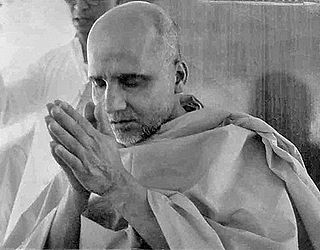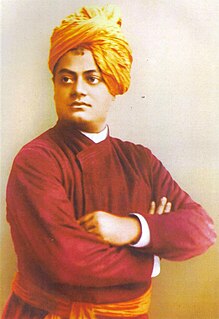Wikipedia Index
For list of articles ordered by topic, see Outline of Hinduism.
For glossary of terms, see Glossary of Hinduism terms.
This articles contains a list of Hinduism-related articles.
| Part of a series on |
| Hinduism |
|---|
 |
This articles contains a list of Hinduism-related articles.
Hinduism is an Indian religion and dharma, or way of life. It is the world's third-largest religion, with over 1.2 billion followers, or 15–16% of the global population, known as Hindus. The word Hindu is an exonym, and while Hinduism has been called the oldest religion in the world, many practitioners refer to their religion as Sanātana Dharma, which refers to the idea that its origins lie beyond human history, as revealed in the Hindu texts. Another, though less fitting, self-designation is Vaidika dharma, the 'dharma related to the Vedas.'

Dayananda Saraswati was an Indian philosopher, social leader and founder of the Arya Samaj, a reform movement of the Vedic dharma. He was the first to give the call for Swaraj as "India for Indians" in 1876, a call later taken up by Lokmanya Tilak. Denouncing the idolatry and ritualistic worship, he worked towards reviving Vedic ideologies. Subsequently, the philosopher and President of India, S. Radhakrishnan called him one of the "makers of Modern India", as did Sri Aurobindo.

Swami Vivekananda, born Narendranath Datta, was an Indian Hindu monk. He was a chief disciple of the 19th-century Indian mystic Ramakrishna. Influenced by Western esotericism, he was a key figure in the introduction of the Indian darsanas of Vedanta and Yoga to the Western world, and is credited with raising interfaith awareness, bringing Hinduism to the status of a major world religion during the late 19th century. He was a major force in the contemporary Hindu reform movements in India, and contributed to the concept of nationalism in colonial India. Vivekananda founded the Ramakrishna Math and the Ramakrishna Mission. He is perhaps best known for his speech which began with the words "Sisters and brothers of America ...," in which he introduced Hinduism at the Parliament of the World's Religions in Chicago in 1893.
The following outline is provided as an overview of and topical guide to Hinduism:
Vedānta is one of the six (āstika) schools of Hindu philosophy. Literally meaning "end of the Vedas", Vedanta reflects ideas that emerged from, or were aligned with, the speculations and philosophies contained in the Upanishads, specifically, knowledge and liberation. Vedanta contains many sub-traditions on the basis of a common textual connection called the Prasthanatrayi: the Upanishads, the Brahma Sutras and the Bhagavad Gita. Some scholars believe Brahma Sutra of vyasa is an interpolation from Madyamaka school of Buddhism.
Several contemporary groups, collectively termed Hindu reform movements or Hindu revivalism, strive to introduce regeneration and reform to Hinduism, both in a religious or spiritual and in a societal sense. The movements started appearing during the Bengali Renaissance.
Sampradaya, in Indian origin religions, namely Hinduism, Buddhism, Jainism and Sikhism, can be translated as 'tradition', 'spiritual lineage', 'sect' or 'religious system'. To ensure continuity and transmission of dharma, various smapardayas have the Guru-shishya parampara in which parampara or lineage of successive gurus (masters) and shishyas (disciples) serves as a spiritual channel and provides a delicate network of relationships that lends stability to a religious identity. Shramana is vedic term for seeker or shishya. Identification with and followership of sampradayas is not static, as sampradayas allows flexibility where one can leave one sampradaya and enter another or practice religious syncretism by simultaneously following more than one sampradaya. Samparda is a punjabi language term, used in Sikhism, for sampradayas.

The Brahmanda Purana is a Sanskrit text and one of the eighteen major Puranas, a genre of Hindu texts. It is listed as the eighteenth Maha-Purana in almost all the anthologies. The text is also referred in medieval Indian literature as the Vayaviya Purana or Vayaviya Brahmanda, and it may have been same as the Vayu Purana before these texts developed into two overlapping compositions.

Hariharanand Saraswati, popularly known as Swami Karpatri or Karpatri ji Maharaj, was born as Har Narayan Ojha into a Saryupareen Brahmin family of a village called Bhatni in Pratapgarh, Uttar Pradesh, India. He was a Sannyasi in the Hindu Dashanami monastic tradition.

Swami Krishnananda Saraswati was a disciple of Sivananda Saraswati and served as the General Secretary of the Divine Life Society in Rishikesh, India from 1958 until 2001. Author of more than 40 texts, and lecturing extensively, on yoga, religion, and metaphysics, Krishnananda was a prolific theologian, saint, yogi and philosopher.

The Shrimad Bhagavad Gita, often referred to as the Gita, is a 700-verse Hindu scripture that is part of the epic Mahabharata, dated to the second half of the first millennium BCE and exemplary for the emerging Hindu synthesis. It is considered to be one of the holy scriptures for Hinduism.
Hindu denominations are traditions within Hinduism centered on one or more gods or goddesses, such as Vishnu, Shiva, Shakti and Brahma. Sometimes the term is used for sampradayas led by a particular guru with a particular philosophy.

The Advaita Guru-Paramparā is the traditional list (parampara) of divine, Vedic and historical teachers of Advaita Vedanta. It begins with the Daiva-paramparā, the gods; followed by the Ṛṣi-paramparā, the Vedic seers; and then the Mānava-paramparā, with the historical teachers Gaudapada and Shankara, and four of Shankara's pupils. Of the five contemporary acharyas, the heads of the five Advaita mathas, four acharyas trace their lineage to those four pupils and one to Adi Shankara himself.

Swami Vivekananda was a Hindu monk from India. His teachings and philosophy are a reinterpretion and synthesis of various strands of Hindu-thought, most notably classical yoga and (Advaita) Vedanta, with western esotericism and Universalism. He blended religion with nationalism, and applied this reinterpretation to various aspect's of education, faith, character building as well as social issues pertaining to India. His influence extended also to the west, and he was instrumental in introducing Yoga to the west.

Neo-Vedanta, also called Hindu modernism, neo-Hinduism, Global Hinduism and Hindu Universalism, are terms to characterize interpretations of Hinduism that developed in the 19th century. The term "Neo-Vedanta" was coined by German Indologist Paul Hacker, in a pejorative way, to distinguish modern developments from "traditional" Advaita Vedanta.
Jainism and Hinduism are two ancient Indian religions. There are some similarities and differences between the two religions. Temples, gods, rituals, fasts and other religious components of Jainism are different from those of Hinduism.

The Babburkamme are a community of Brahmins in India. They belong to Hindu Pancha Dravida Smartha Brahmin. According to one published source, the Kamme communities might have migrated south through dominion of Satavahanas over a long period to the Chalukya, Rashtrakuta, the Vijayanagara kingdom and later to Mysore Kingdom towards southern Karnataka and Tamil Nadu. They have been holding highly politically influencing position such ministers, chief priests, scholars and poets under different kingdoms. A related community are today known as Uluchu Kamme has Kannada as their mother tongue.

The Swaminarayan Bhashyam (Svāminārāyaṇabhāṣyam) is a five-volume Sanskrit bhashya, or commentary, on the Prasthanatrayi (Prasthānatrayī) - the ten principal Upanishads (Upaniṣads), the Bhagavad Gita (Bhagavadgītā), and the Brahmasutras (Brahmasūtras) - which establishes the principles taught by Swaminarayan as perceived by the BAPS.